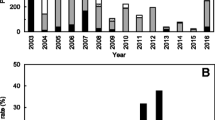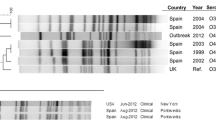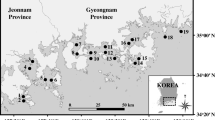Abstract
Vibrio parahaemolyticus is a Gram-negative, halophilic bacterium found commonly in temperate and warm estuarine waters worldwide. V. parahaemolyticus is considered an emerging bacterial pathogen in Europe and has been responsible for several recent seafood-associated outbreaks. During ad hoc testing of raw shellfish produce in May 2012, pandemic group (O3:K6) V. parahaemolyticus was isolated from Pacific oysters (Crassostrea gigas), harvested in Southern England. Follow-on testing of water and shellfish, encompassing a small number geographically diverse sites, also retrieved pandemic group isolates. These strains are amongst the most northerly pandemic strains described to date and represent the first instance of pandemic V. parahaemolyticus isolated in the UK, highlighting the expanding geographical distribution of these foodborne pathogens in the environment.
Similar content being viewed by others
Avoid common mistakes on your manuscript.
Introduction
Globally, Vibrio parahaemolyticus is the leading cause of bacterial gastroenteritis associated with the consumption of seafood produce. Clinical characteristics of V. parahaemolyticus infections include abdominal cramps, diarrhoea, nausea, headaches, fever and chills [6]. The presence of V. parahaemolyticus in the marine environment is closely related to water temperature, with strains readily isolated when environmental temperatures exceed 15 °C [1, 8]. Until 1996, V. parahaemolyticus infections were typically sporadic, with few largescale foodborne outbreaks. In 1996, a sudden increase in V. parahaemolyticus infections emerged in Calcutta, India, with a distinctive serotype (O3:K6). This serotype, subsequently termed the ‘pandemic group’, rapidly disseminated around the globe and has been responsible for large foodborne outbreaks across Asia, Africa and America [13]. Recent reports suggest that the number of V. parahaemolyticus infections appear to be increasing in Europe [1]; however, regionally, little data exists on the role of pandemic V. parahaemolyticus strains as a cause of disease. A small number of recent O3:K6 strains responsible for foodborne infections have been reported in Spain [10], Italy [16, 17] and France [18]. Toxigenic V. parahaemolyticus is considered relatively rare in the natural environment, with typically less than 5 % of strains believed to be able to initiate disease in humans. Few studies have attempted to analyse the prevalence of toxigenic strains of V. parahaemolyticus, although reports in Southern Europe have indicated the presence of haemolysin genes exceeding 5 % in water and shellfish samples Serracca et al. [20]. The vast majority of pathogenic strains produce just two recognized virulence factors during pathogenesis. Of these, the thermostable direct haemolysin (TDH) [2, 14], responsible for the Kanagawa haemolysis, and the TDH-related haemolysin (TRH) [7] are considered the most predictive overall indicators of potential virulence [1] (Fig. 1).
PCR analysis of a representative recovered V. parahaemolyticus strain, using assays specific for trh, tdh and group-specific pandemic PCR. Lane 1, 100 bp DNA ladder (Promega); lane 2, positive control DNA (trh+ isolate); lane 3, recovered strain; lane 4, negative control (water). Lane 5, positive control DNA (library pandemic strain); lane 6, recovered strain; lane 7, negative control (water). Lane 8, positive control DNA (tdh+ strain); lane 9, recovered strain; lane 10, negative control (water)
Materials and Methods
During May–October 2012, we tested shellfish samples (Pacific oyster, C. gigas) from two commercial shellfish harvesting areas (sites 1 and 2), as well as 10 l marine water samples from a separate site, in the South West UK (site 3). The samples were obtained monthly from site 1, once only for site 2 (July 2012) and monthly (July–October 2012) for site 3. Shellfish samples were transported to the laboratory on ice and processed immediately upon receipt. Shellfish were washed and opened aseptically, and the meat and intravalvular fluid of ten individual animals were pooled together. From the sample, 25 g was removed and stomached (model 400 Seward stomacher; Seward, Ltd.) for 3 min. Sterile alkaline saline peptone water (ASPW) (75 ml) was added making a 1:3 dilution, and the mixture was stomached for 3 min. A further 150 ml of sterile ASPW was added and then incubated at 41.5 ± 1 °C for 6 h. This enrichment broth was then subcultured onto selective media, including thiosulfate citrate bile sucrose (TCBS) agar (Oxoid Ltd.), chromID Vibrio agar and VID agar (Biomerieux, Marcy l'Etoile, France). Samples were incubated for 24 h at 37 °C. Following incubation, colonies were selected on the basis of distinctive morphology and colour, and further enriched on Marine Agar plates (Difco) for 24 h at 30 °C. Presumptive Vibrio strains were then identified to species level biochemically using API20E (Biomerieux).
As part of this short ad hoc microbiological testing, presumptive Vibrio species were isolated following alkaline APW broth enrichment, originally from site 1, in May 2012. Based on colony morphology on selective agar (marine agar, TCBS and VID agar) and tolerance to 8 % NaCl, V. parahaemolyticus was suspected. Presumptive V. parahaemolyticus strains were also isolated in July (site 2) and August (sites 1, 2 and 3). Microbiological analysis was subsequently performed on the isolated bacterial strains using a range of culture-based and molecular testing approaches. A preliminary identification of V. parahaemolyticus was made after biochemical analysis using API20E (Biomerieux, Marcy l'Etoile, France), according to manufacturers recommendations. For DNA extraction, a loopful of colonies was chosen and resuspended in 300-μl sterile distilled water and boiled for 10 min to lyse cells. Presumptive V. parahaemolyticus strains isolated from marine agar plates were subsequently analysed by polymerase chain reaction (PCR), using two species-specific assays (tlh and toxR) that target V. parahaemolyticus [2, 9, 15]. In addition, the presence of the virulence genes tdh and trh were determined by multiplex PCR according to the procedure described by Bej et al. [2]. The amplicons were analysed in a 2.0 % agarose gel. Following PCR for toxR, tlh, tdh and trh, all strains were subsequently tested using primers that target the group-specific sequence variation in the toxRS gene, as previously described [12]. Following boiling, the lysate was centrifuged briefly, and the supernatant containing DNA was used directly during PCR. As a further confirmatory step, strains were submitted to a separate laboratory (School of Biosciences, University of Exeter) for additional PCR testing using toxR and group-specific primer sets, essentially as described above.
Serological analysis of all strains was determined by agglutination using commercially available V. parahaemolyticus antisera (Denka Seiken Ltd., Tokyo). All isolates were grown on TSA agar with 3 % NaCl and 0.1 % Teepol. For K-type determination, a bacterial suspension was made in 3 % NaCl solution, whilst O-type determination was performed using bacterial suspension in 3 % NaCl supplemented with 5 % glycerol. Strains were boiled for 1 h and centrifuged for 5 m prior to the addition of 10 μl of polyvalent sera and 10 μl of boiled cell sample on glass slides (76 × 26 mm). The slide was tilted back and forth for 1 min until agglutination was observed. Reactions were performed using a range of monovalent O antigens (0–11) and K antigens (1–61) according to the manufacturer’s antigenic scheme.
Results and Discussion
During ad hoc sampling of shellfish and water samples, we isolated pandemic (O3:K6) V. parahaemolyticus from several sites in Southern England during the summer of 2012. All V. parahaemolyticus strains demonstrated typical molecular and biochemical characteristics associated with ‘pandemic group’ status strains, namely the possession of thermostable direct haemolysin (tdh+) coupled to the absence of the tdh-related haemolysin gene (trh). In addition, all tested strains demonstrated the serotype O3:K6, indicative of pandemic strains reported worldwide [13]. These strains represent, to our knowledge, the first report of pandemic O3:K6 V. parahaemolyticus isolated in the United Kingdom. These findings are significant for a number of reasons. Firstly, although other studies have demonstrated the presence of pandemic strains in marine water samples in Europe, as well as clinical cases, most instances to date have been reported in Southern Europe [10, 16–18]. With the exception of a single clinical case of pandemic V. parahaemolyticus in Norway in 2002, and believed to be domestically acquired [4], we believe that these bacterial strains represent the most northerly identified pandemic strains isolated directly from the environment. Secondly, these strains were recovered during a relatively mild summer in the UK in terms of sea surface temperatures. The UK mean temperature for summer was 13.9 °C, which is 0.4 °C below average. Other than 2011, the summer of 2012 was the coolest summer since 1998 [11]. For instance, for sites 1 and 2 (shellfish harvesting areas), temperatures did not exceed 20 °C during the entire summer period. Of interest, the environmental temperatures were typically less than 15 °C at site 1 when the pandemic strains were initially isolated in May 2012. Given that numerous V. parahaemolyticus outbreaks in Europe have been linked to anomalously warm weather episodes, the isolation of pandemic strains during a cold summer in Northern latitudes is therefore striking. Previous studies have demonstrated an inverse relationship between environmental temperature and the recovery of tdh+ strains [3, 19]. It will be of interest to determine if the tdh+ strains isolated as part of this work are adapted to survive at unusually low temperatures. Finally, the isolation of pandemic strains from a range of different geographical sites in Southern England during a relatively short sampling programme, including shellfish and water samples (May–September 2012, Table 1), is suggestive that these potentially pathogenic strains may be ubiquitous in the marine environment. Recent studies analysing the presence of V. parahaemolyticus in UK shellfish produce did not report the isolation of pandemic strains [21]; however, a lack of long-term and systematic surveillance data precludes us from establishing whether these strains have emerged recently or not in the UK waters.
We must stress that the relative numbers of recovered pandemic strains from raw shellfish produce were low, and these bacteria were isolated after an initial enrichment step. In addition, the shellfish produce that was selected for testing had not undergone purification—a legislative requirement for the majority of bivalve shellfish produced in Southern England—thus, the number of pandemic isolates in purified shellfish produce may be substantially lower than those likely to initiate infection based on current risk assessments [5]. Irrespective, the isolation of pandemic group strains from temperate environmental sources is striking and highlights the potential for temperature abuse of raw shellfish produce as a potential risk factor, as implicated in past outbreaks caused by pandemic strains in Europe [10]. Preliminary molecular analyses including PFGE on a subset of the strains presented here indicates that these bacteria may represent novel isolates when compared to other pandemic V. parahaemolyticus strains in Europe. It will be of interest to compare these strains alongside a geographically and clinically diverse group of pandemic strains, encompassing both European and non-European V. parahaemolyticus isolates. Current work utilising a range of typing approaches will provide further insights into the evolutionary and phylogenetic relatedness of these strains. Future work should include a quantitative surveillance analysis of the seasonal and geographical distributions of these pathogens in unpurified bivalve shellfish in the UK and potentially elsewhere in Northwest Europe.
References
Baker-Austin C, Stockley L, Rangdale R, Martinez-Urtaza J (2010) Environmental occurrence and clinical impact of Vibrio vulnificus and Vibrio parahaemolyticus: a European perspective. Environ Microbiol Rep 2:7–18
Bej AK, Patterson DP, Brasher CW, Vickery MCL, Jones DD, Kaysner C (1999) Detection of total and hemolysin producing Vibrio parahaemolyticus in shellfish using multiplex PCR amplification of tl, tdh, and trh. J Microbiol Methods 36:215–225
DePaola A, Nordstrom JL, Bowers JC, Wells JG, Cook DW (2003) Seasonal abundance of total and pathogenic Vibrio parahaemolyticus in Alabama oysters. Appl Environ Microbiol 69:1521–1526
Ellingsen AB, Jorgensen H, Wagley S, Monshaugen M, Rorvik LM (2008) Genetic diversity among Norwegian Vibrio parahaemolyticus. J Appl Microbiol 105:2195–2202
Food and Drug Administration (2005) Quantitative risk assessment on the public health impact of pathogenic Vibrio parahaemolyticus in raw oysters. US Food and Drug Administration, Washington
Honda T, Iida T (1993) The pathogenicity of Vibrio parahaemolyticus and the role of the thermostable direct haemolysin and related haemolysins. Rev Med Microbiol 4:106–113
Honda T, Ni Y, Miwatani T (1988) Purification and characterization of a hemolysin produced by clinical isolates of Kanagawa phenomenon negative V. parahemolyticus related to the thermostable direct hemolysin. Infect Immun 56:961–965
Kaneko T, Colwell RR (1973) Ecology of Vibrio parahaemolyticus in Chesapeake Bay. J Bacteriol 113(1):24–32
Kim YB, Okuda J, Matsumoto C, Takahashi N, Hashimoto S, Nishibuchi M (1999) Identification of Vibrio parahaemolyticus strains at the species level by PCR targeted to the toxR gene. J Clin Microbiol 37:1173–1177
Martinez-Urtaza J, Simental L, Velasco D, DePaola A, Ishibashi M, Nakaguchi Y, Nishibuchi M, Carrera-Flores D, Rey-Alvarez C, Pousa A (2005) Pandemic Vibrio parahaemolyticus O3:K6, Europe. Emerg Infect Dis 11:1319–1320
Met Office (2012) Summer 2012. http://www.metoffice.gov.uk/climate/uk/2012/summer.html. Accessed 24 September 2012
Okura M, Osawa R, Iguchi A, Arakawa E, Terajima J, Watanabe H (2003) Genotypic analyses of Vibrio parahaemolyticus and development of a pandemic group-specific multiplex PCR assay. J Clin Microbiol 41:4676–4682
Nair GB, Ramamurthy T, Bhattacharya SK, Dutta B, Takeda Y, Sack DA (2007) Global dissemination of Vibrio parahaemolyticus serotype O3:K6 and its serovariants. Clin Microbiol Rev 20:39–48
Nishibuchi M, Fasano A, Russell RG, Kaper JB (1992) Enterotoxigenicity of Vibrio parahaemolyticus with and without genes encoding thermostable direct hemolysin. Infect Immun 60:3539–3545
Nordstrom JL, Vickery MC, Blackstone GM, Murray SL, DePaola A (2007) Development of a multiplex real-time PCR assay with an internal amplification control for the detection of total and pathogenic Vibrio parahaemolyticus bacteria in oysters. Appl Environ Microbiol 73:5840–5847
Ottaviani D, Leoni F, Rocchegiani E, Canonico C, Potenziani S, Santarelli S, Masini L, Mioni R, Carraturo A (2010) Prevalence, serotyping and molecular characterization of Vibrio parahaemolyticus in mussels from Italian growing areas, Adriatic Sea. Environ Microbiol Rep 2:192–197
Ottaviani D, Leoni F, Rocchegiani E, Canonico C, Potenziani S, Santarelli S, Masini L, Scuota S, Carraturo A (2010) Vibrio parahaemolyticus-associated gastroenteritis in Italy: persistent occurrence of O3:K6 pandemic clone and emergence of O1:KUT serotype. Diagn Microbiol Infect Dis 66:452–455
Quilici ML, Robert-Pillot A, Picart J, Fournier JM (2005) Pandemic Vibrio parahaemolyticus O3:K6 spread, France. Emerg Infect Dis 11:1148–1149
Rodriguez-Castro A, Ansede-Bermejo J, Blanco-Abad V, Varela-Pet J, Garcia-Martin O, Martinez-Urtaza J (2010) Prevalence and genetic diversity of pathogenic populations of Vibrio parahaemolyticus in coastal waters of Galicia, Spain. Environ Microbiol Rep 2:58–66
Serracca L, Battistini R, Rossini I, Prearo M, Ottaviani D, Leoni F, Ercolini C (2011) Vibrio virulence genes in fishes collected from estuarine waters in Italy. Appl Microbiol 5:403–408
Wagley S, Koofhethile K, Rangdale R (2009) Prevalence and potential pathogenicity of Vibrio parahaemolyticus in Chinese mitten crabs (Eriocheir sinensis) harvested from the River Thames estuary, England. J Food Prot 72:60–66
Author information
Authors and Affiliations
Corresponding author
Rights and permissions
About this article
Cite this article
Powell, A., Baker-Austin, C., Wagley, S. et al. Isolation of Pandemic Vibrio parahaemolyticus from UK Water and Shellfish Produce. Microb Ecol 65, 924–927 (2013). https://doi.org/10.1007/s00248-013-0201-8
Received:
Accepted:
Published:
Issue Date:
DOI: https://doi.org/10.1007/s00248-013-0201-8





